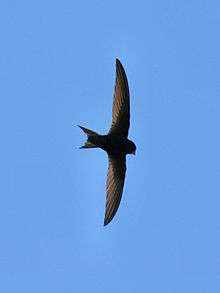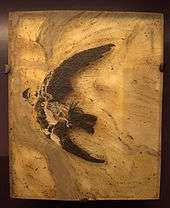Swift
The swifts are a family, Apodidae, of highly aerial birds. They are superficially similar to swallows, but are not closely related to any passerine species. Swifts are placed in the order Apodiformes with hummingbirds. The treeswifts are closely related to the true swifts, but form a separate family, the Hemiprocnidae.
| Swift Temporal range: Eocene to present | |
|---|---|
 | |
| Common swift, Apus apus | |
| Scientific classification | |
| Kingdom: | Animalia |
| Phylum: | Chordata |
| Class: | Aves |
| Order: | Apodiformes |
| Family: | Apodidae Hartert, 1897 |
| Subfamilies | |
Resemblances between swifts and swallows are due to convergent evolution, reflecting similar life styles based on catching insects in flight.
The family name, Apodidae, is derived from the Greek ἄπους (ápous), meaning "footless", a reference to the small, weak legs of these most aerial of birds.[1][2] The tradition of depicting swifts without feet continued into the Middle Ages, as seen in the heraldic martlet.
Taxonomy

Taxonomists have long classified swifts and treeswifts as relatives of the hummingbirds, a judgment corroborated by the discovery of the Jungornithidae (apparently swift-like hummingbird-relatives) and of primitive hummingbirds such as Eurotrochilus. Traditional taxonomies place the hummingbird family (Trochilidae) in the same order as the swifts and treeswifts (and no other birds); the Sibley-Ahlquist taxonomy treated this group as a superorder in which the swift order was called Trochiliformes.
The taxonomy of the swifts is complicated, with genus and species boundaries widely disputed, especially amongst the swiftlets. Analysis of behavior and vocalizations is complicated by common parallel evolution, while analyses of different morphological traits and of various DNA sequences have yielded equivocal and partly contradictory results.[3]
The Apodiformes diversified during the Eocene, at the end of which the extant families were present; fossil genera are known from all over temperate Europe, between today's Denmark and France, such as the primitive swift-like Scaniacypselus[4] (Early – Middle Eocene) and the more modern Procypseloides (Late Eocene/Early Oligocene – Early Miocene). A prehistoric genus sometimes assigned to the swifts, Primapus (Early Eocene of England), might also be a more distant ancestor.
Description
Swifts are among the fastest of birds, and larger species like the white-throated needletail have been reported travelling at up to 169 km/h (105 mph)[6] in level flight. Even the common swift can cruise at a maximum speed of 31 metres per second (112 km/h; 70 mph). In a single year the common swift can cover at least 200,000 km.[7] and in a lifetime, about two million kilometers; enough to fly to the Moon five times over.[8]
The wingtip bones of swiftlets are of proportionately greater length than those of most other birds. Changing the angle between the bones of the wingtips and forelimbs allows swifts to alter the shape and area of their wings to increase their efficiency and maneuverability at various speeds.[9] They share with their relatives the hummingbirds a unique ability to rotate their wings from the base, allowing the wing to remain rigid and fully extended and derive power on both the upstroke and downstroke.[10] The downstroke produces both lift and thrust, while the upstroke produces a negative thrust (drag) that is 60% of the thrust generated during the downstrokes, but simultaneously it contributes lift that is also 60% of what is produced during the downstroke. This flight arrangement might benefit the bird's control and maneuverability in the air.[11]
The swiftlets or cave swiftlets have developed a form of echolocation for navigating through dark cave systems where they roost.[12] One species, the Three-toed swiftlet, has recently been found to use this navigation at night outside its cave roost too.
Distribution and habitat
Swifts occur on all the continents except Antarctica, but not in the far north, in large deserts, or on many oceanic islands.[13] The swifts of temperate regions are strongly migratory and winter in the tropics. Some species can survive short periods of cold weather by entering torpor, a state similar to hibernation.[12]
Many have a characteristic shape, with a short forked tail and very long swept-back wings that resemble a crescent or a boomerang. The flight of some species is characterised by a distinctive "flicking" action quite different from swallows. Swifts range in size from the pygmy swiftlet (Collocalia troglodytes), which weighs 5.4 g and measures 9 cm (3.5 in) long, to the purple needletail (Hirundapus celebensis), which weighs 184 g (6.5 oz) and measures 25 cm (9.8 in) long.[12]
Behaviour
Breeding
_on_nest_(15593076875).jpg)
The nest of many species is glued to a vertical surface with saliva, and the genus Aerodramus use only that substance, which is the basis for bird's nest soup. The eggs hatch after 19 to 23 days, and the young leave the nest after a further six to eight weeks. Both parents assist in raising the young.[12]
Swifts as a family have smaller egg clutches and much longer and more variable incubation and fledging times than passerines with similarly sized eggs, resembling tubenoses in these developmental factors. Young birds reach a maximum weight heavier than their parents; they can cope with not being fed for long periods of time, and delay their feather growth when undernourished. Swifts and seabirds have generally secure nest sites, but their food sources are unreliable, whereas passerines are vulnerable in the nest but food is usually plentiful.[14][15]
Feeding
All swifts eat insects, such as aerial spiders, dragonflies, flies, ants, aphids, wasps and bees. Some species, like the chimney swift, hunt with other bird species as well.
Status
No swift species has become extinct since 1600,[16] but BirdLife International assesses the Guam swiftlet as endangered and lists the Atiu, dark-rumped, Schouteden's, Seychelles and Tahiti swiftlets as vulnerable; twelve other species are near threatened or lack sufficient data for classification.[17]
Exploitation by humans
The hardened saliva nests of the edible-nest swiftlet and the black-nest swiftlet have been used in Chinese cooking for over 400 years, most often as bird's nest soup.[18] Over-harvesting of this expensive delicacy has led to a decline in the numbers of these swiftlets,[19][20] especially as the nests are also thought to have health benefits and aphrodisiac properties. Most nests are built during the breeding season by the male swiftlet over a period of 35 days. They take the shape of a shallow cup stuck to the cave wall. The nests are composed of interwoven strands of salivary cement and contain high levels of calcium, iron, potassium, and magnesium.[20]
References
- Jobling (2010) pp. 50–51.
- Kaufman (2001) p. 329.
- Thomassen, Henri A.; Tex, Robert-Jan; de Bakker, Merijn A.G.; Povel, G. David E. (2005). "Phylogenetic relationships amongst swifts and swiftlets: A multi locus approach". Molecular Phylogenetics and Evolution. 37 (1): 264–277. doi:10.1016/j.ympev.2005.05.010. PMID 16006151.
- Mayr, Gerald (2003). "A new Eocene swift-like bird with a peculiar feathering" (PDF). Ibis. 145 (3): 382–391. doi:10.1046/j.1474-919x.2003.00168.x. Archived from the original (PDF) on 2016-03-03. Retrieved 2013-10-27.
- Chantler & Driessens (2000) pp. 19–20
- Bourton, Jody (2 March 2010). "Supercharged swifts fly fastest". BBC News.
- Piper, Ross (2007), Extraordinary Animals: An Encyclopedia of Curious and Unusual Animals, Greenwood Press,
- Rundell, Katherine (August 15, 2019). "Consider the Swift". London Review of Books.
- On Swift Wings | Natural History Magazine
- Birds of Venezuela – Steven L. Hilty
- Vortex wake and flight kinematics of a swift in cruising flight in a wind tunnel
- Collins, Charles T. (1991). Forshaw, Joseph (ed.). Encyclopaedia of Animals: Birds. London: Merehurst Press. pp. 134–136. ISBN 1-85391-186-0.
- Martins, Thais; Mead, Christopher J. (2003). "Swifts". In Perrins, Christopher (ed.). The Firefly Encyclopedia of Birds. Firefly Books. pp. 346–350. ISBN 1-55297-777-3.
- Lack, David; Lack, Elizabeth (1951). "The breeding biology of the Swift Apus apus". Ibis. 93 (4): 501–546. doi:10.1111/j.1474-919X.1951.tb05457.x.
- Boersma, P Dee (1982). "Why some birds take so long to hatch". The American Naturalist. 120 (6): 733–750. doi:10.1086/284027. JSTOR 2461170.
- del Hoyo, Josep; Elliott, Andrew; Sargatal, Jordi; Christie, David A.; de Juana, Eduardo (eds.). "Apodidae". Handbook of the Birds of the World Alive. Lynx Edicions. Retrieved 10 September 2013.
- "Apodidae". Species. BirdLife International. Retrieved 27 October 2013.
- Hobbs, Joseph J (2004). "Problems in the harvest of edible birds' nests in Sarawak and Sabah, Malaysian Borneo". Biodiversity and Conservation. 13 (12): 2209–2226. doi:10.1023/b:bioc.0000047905.79709.7f.
- Gausset, Quentin (2004). "Chronicle of a Foreseeable Tragedy: Birds' Nests Management in the Niah Caves (Sarawak)". Human Ecology. 32 (4): 487–506. doi:10.1023/b:huec.0000043517.23277.54.
- Marcone, Massimo F (2005). "Characterization of the edible bird's nest the Caviar of the East". Food Research International. 38 (10): 1125–1134. doi:10.1016/j.foodres.2005.02.008.
Bibliography
- Chantler, Phillip; Driessens, Gerald (2000). Swifts: A Guide to the Swifts and Treeswifts of the World. London: Pica Press. ISBN 1-873403-83-6.
- Jobling, James A (2010). The Helm Dictionary of Scientific Bird Names. London: Christopher Helm. ISBN 978-1-4081-2501-4.
- Walker, Mark (2016). Swift Summers. Sheffield: Sicklebrook Publishing. ISBN 1329963091. Online copy to download
- Kaufman, Kenn (2001). Lives of North American Birds. Oxford: Houghton Mifflin Harcourt. ISBN 0-618-15988-6.
External links
| Wikimedia Commons has media related to Apodidae. |
- Swift sounds on xeno-canto.org
- Swift Conservation.Org free advice on the natural history and conservation of Apus apus the Common Swift